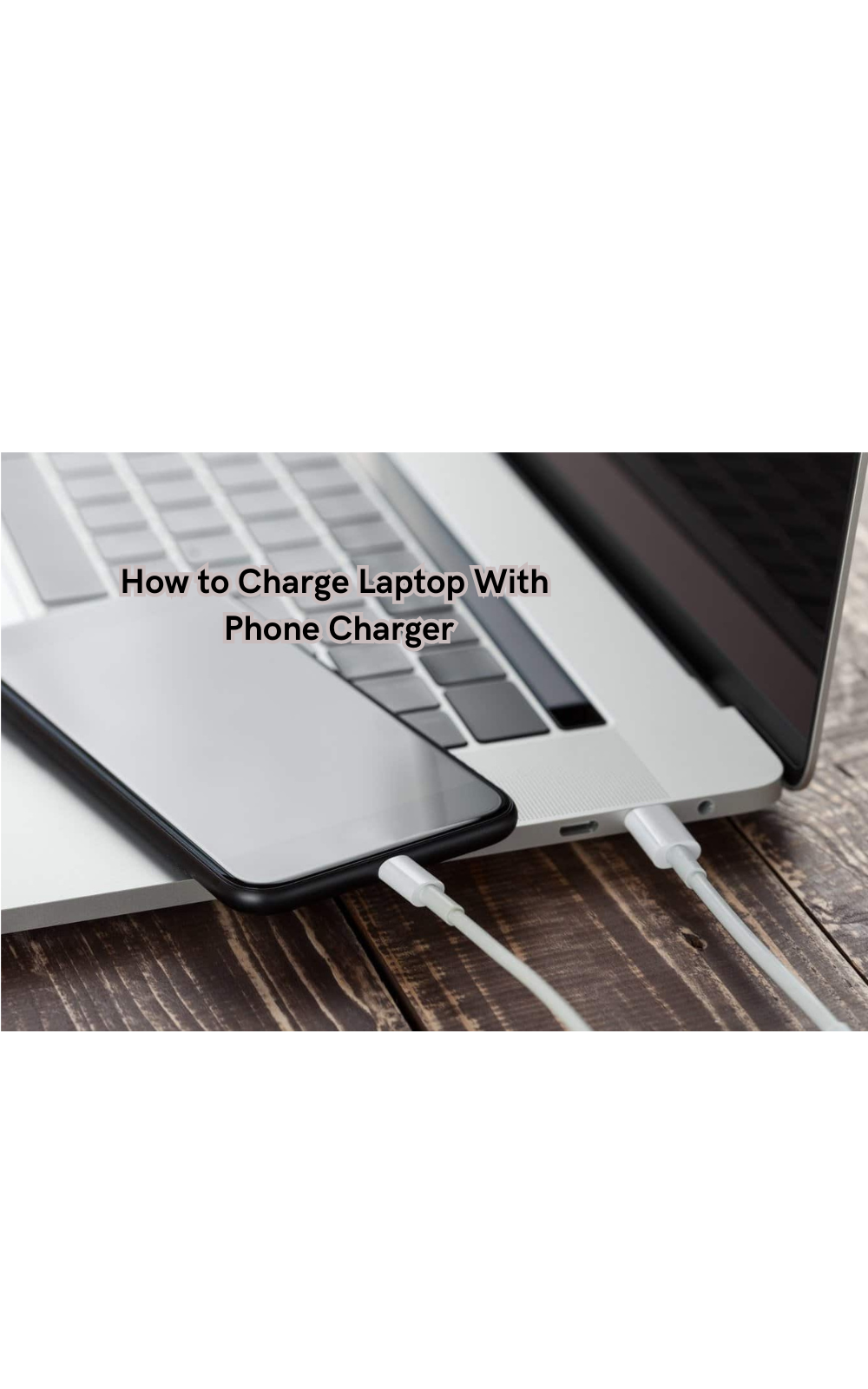How to Charge Laptop With Phone Charger
Exploring this alternative charging method requires knowledge of device compatibility and power specifications to ensure safe and efficient charging. Here are some tips for charging your laptop with a phone charger:

Charging a laptop with a phone charger is a convenient solution in moments when traditional laptop chargers are unavailable. While this practice can work for some laptops, it's important to proceed with caution and understand the compatibility and power requirements of both devices.
Typically, laptops require more power to charge compared to phones, so using a phone charger may result in slower charging or insufficient power delivery. However, certain laptops with USB-C ports that support Power Delivery can be charged using higher wattage phone chargers.
Exploring this alternative charging method requires knowledge of device compatibility and power specifications to ensure safe and efficient charging. Here are some tips for charging your laptop with a phone charger:
Understand Check Compatibility
Before attempting to charge your laptop with a phone charger, it's crucial to check the compatibility between the two devices. The easiest way to do this is by looking at the charging port of your laptop and phone. If both devices have USB-C ports, there's a high chance that they are compatible for charging. However, if your laptop has a different port, you may need an adapter or converter to connect it to the phone charger.
Additionally, check the power requirements of your laptop and phone. A typical laptop requires anywhere from 60-90 watts of power, while phones usually require around 15 watts or less. Make sure that the phone charger can deliver enough power to charge your laptop, or else it may result in slower charging or not charging at all.
Differences Between Phone and Laptop USB-C Chargers
While both phone and laptop chargers use a USB-C port, there are some key differences between them. These include the wattage output, voltage, and amperage. A phone charger usually delivers around 5 volts and 3 amps, while a laptop charger can deliver up to 20 volts and 4-10 amps depending on the model.
The wattage of a charger is determined by multiplying the voltage by the amperage. For example, a phone charger with an output of 5V/3A has a wattage of 15 watts (5 x 3 = 15). On the other hand, a laptop charger with an output of 20V/5A has a wattage of 100 watts (20 x 5 = 100). This significant difference in wattage is important to consider when attempting to charge your laptop with a phone charger.
What to Consider When Charging a Laptop with a USB-C Phone Charger?
If your laptop and phone charger are compatible and the charger can deliver enough power, there are still some things to consider when charging your laptop.
- Temperature: Charging a laptop with a phone charger may cause the device to heat up more than usual. Make sure to monitor the temperature of your laptop while it's charging and unplug it if it becomes too hot.
- Charging speed: As mentioned earlier, using a phone charger may result in slower charging times for your laptop. This is because phone chargers have lower wattage outputs compared to typical laptop chargers.
- Battery life: Repeatedly charging your laptop with a phone charger may affect its battery life in the long run. This is because the voltage and amperage of these chargers are designed for smaller devices like phones, not laptops.
- Check the cord: Ensure that the USB-C cable used to connect the phone charger to your laptop is in good condition and can handle higher wattages. If it's frayed or damaged, it may result in inefficient charging or even cause damage to both devices.
These considerations are important to keep in mind in order to safely and effectively charge your laptop with a phone charger.
How to Charge Laptop With Phone Charger?
If you've checked compatibility, made sure the charger can deliver enough power, and considered the factors mentioned above, you can now proceed with charging your laptop using a phone charger.
Turn off your laptop:
Before connecting the phone charger, make sure your laptop is turned off. This can help prevent any potential damage to the device while charging.
Connect the USB-C cable:
Plug one end of the USB-C cable into your phone charger and the other end into your laptop's USB-C port.
Monitor temperature and charging progress:
As mentioned earlier, keep an eye on the temperature of your laptop while it's charging and monitor how quickly it's charging.
Unplug when fully charged:
Once your laptop is fully charged, unplug the phone charger and turn on your laptop to resume use.
These are the basic steps to charge your laptop with a phone charger. However, keep in mind that this method may not work for all laptops and can potentially cause harm if not done properly.
Safety Tips for Charging Your Laptop with a USB-C Charger
Now that you know how to charge your laptop with a phone charger, here are some safety tips to keep in mind:
- Use OEM chargers: Whenever possible, use the manufacturer's original charger for your laptop. This ensures compatibility and reduces the risk of damage to your device.
- Don't use cheap or uncertified chargers: It may be tempting to purchase a cheaper phone charger, but these may not have proper safety certifications and can potentially damage your devices.
- Avoid using extension cords: Using an extension cord with a phone charger may cause power fluctuations, which can be harmful to both devices.
- Avoid overcharging: Once your laptop is fully charged, unplug it from the phone charger. Keeping it connected for an extended period can cause damage to the battery.
- Keep an eye on your devices: As mentioned earlier, always monitor the temperature and charging progress of your laptop while using a phone charger. If anything seems unusual or unsafe, unplug it immediately.
These safety tips are important to consider to ensure a safe and efficient charging experience for your laptop. With the proper knowledge and precautions, using a phone charger to charge your laptop can be a convenient alternative when you're in a pinch or traveling without your original charger.
Additional 3 Ways to Charge Your Laptop Without a Charger
In some cases, you may not have access to your laptop charger or a phone charger with compatible outputs. In these situations, here are three alternative ways to charge your laptop without a charger:
- Using a power bank: If you have a power bank with USB-C ports and enough wattage output, you can use it to charge your laptop on the go.
- Using an AC adapter: Some laptops come with detachable AC adapters that allow you to plug them directly into an outlet. This eliminates the need for a traditional charging block and cable.
- Using solar power: Solar panels have become increasingly popular as a sustainable charging solution for electronic devices. You can find solar chargers specifically designed for laptops that use USB-C ports. Keep in mind that the charging time may be longer compared to traditional methods, and it may not work on cloudy days.
These alternative methods may not be as convenient or efficient as using a charger specifically made for your laptop, but they can be useful in emergency situations. It's essential to research and ensure compatibility before attempting to charge your laptop with these alternative methods.
FAQs
Can you charge a laptop using a USB C laptop charger designed for phones?
Yes, you can charge a laptop using a USB C laptop charger designed for phones if both the charger and the laptop support USB Power Delivery (USB PD). This standard allows for higher power to be delivered, suitable for charging laptops via USB C charging. Always check your laptop’s user manual to confirm compatibility before using a phone charger.
What is USB Power Delivery, and how does it relate to charging laptops?
USB Power Delivery (USB PD) is a charging protocol that allows for higher power transfer over USB connections, including USB C connectors. This technology enables compatible devices, such as certain laptops, to charge at a much faster rate than standard USB charging options. It’s important to use a charger and USB C cables that support USB PD to take advantage of this feature.
How do I know if my laptop can be charged using a USB C connector from a phone charger?
To determine if your laptop can be charged using a USB C connector from a phone charger, consult your laptop’s user manual. The manual will specify if your laptop supports USB C charging and if it is compatible with USB Power Delivery, which is necessary for charging laptops using phone chargers.
What should I do if my laptop only has USB A ports but I want to use a USB C phone charger?
If your laptop only has USB A ports and you want to use a USB C phone charger, you will likely not be able to charge your laptop this way. USB A ports do not support the USB C charging protocol or USB Power Delivery, and they typically cannot handle the power requirements needed to charge laptops. It's recommended to use a charger designed for your specific laptop type.
Conclusion
In conclusion, while charging a laptop with a phone charger can be a temporary solution in emergencies, it's crucial to exercise caution and consider the compatibility and power requirements of both devices.
Using a phone charger to charge a laptop may result in slower charging times or inadequate power delivery due to differing wattage needs.
However, for laptops equipped with USB-C ports that support Power Delivery, higher wattage phone chargers can be a viable option. Understanding the limitations and specifics of your devices is essential to ensure safe and efficient charging when resorting to this alternative method.
